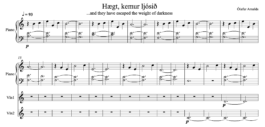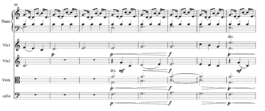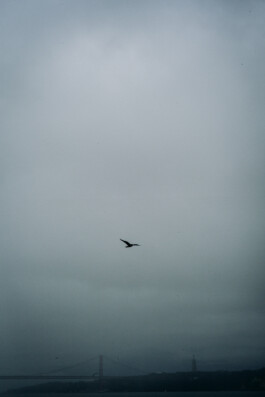__
I study composers to find out why their music touches me so much. I am writing here my view of some pieces.
__
Hægt, kemur ljósið
by Ólafur Arnalds
This song from 2010 touched me and represents the mood of the composer from Iceland.
Ólafur simply begins with a fragile but forward-looking piano section, which alternately plays the delicate, delicately sensitive and thoughtful major seventh chords with harmonies from the scale. The key in A minor reinforces this initial character. Berlioz already used to say the following about the key in A minor: "quite complete, sweet, sad, relatively sublime."
There is a gentle inkling of the light, which is also indicated in the video, not real, but only in dreams.
When the strings begin to begin - and mostly with Ólafur Arnalds I feel a supporting, already maternal or paternal component of the arrangement of the strings - the window opens and the bird is given the opportunity to think about breaking out.

It is interesting that the strings absorb the dissonant tension right from the start. Violin II begins with the dominant E (from A) in bar 25, while violin I with an F causes the tension in bar 27. The strings that give the walking piano the security and the basis show solidarity with the fragility of the piano, so to speak.
But with the next note G in bar 29 there is now a third and this gives the feeling that the strings form the wide horizon of the bird, which slowly but boldly develops in it.
Encouraged and backed by the security strings, the piano in bar 41 begins to develop a bouncy character.

With the use of viola and cello, the bird in bar 53 is encouraged to consider the open window more and more and to get out of the darkness of his home. This shows the viola, "the violin tuned deeper by the fifth" and the cello is given further strengthening and depth of field for the bird.
When percussions begin in measure 61, the bird flies off. While the strings stand for deep motivation and encouragement, the drums stand for subsequent action - the bird pursues its longing for the light.
The strings gave him a hunch, the percussions kicked the ass.

From bar 69, the bird's hope and the will to strive for the light intensify, as Ólafur begins staccato in the strings. In bar 74 the percussions with quarters follow, again encouraged by the strings, who give security in this piece.
Up to bar 95, the song builds up in an exciting and hopeful way, until it then reaches the peak of confidence in this bar.

Violin I., which has taken the lead in this part, resigns, now the strings have fulfilled their purpose: they have opened up the prospect of hope. The bird is still flying in snow and rain, and yet everyone knows that happiness is already in the way. The way is the goal because curiosity carries hope.
Violin I's mission is accomplished.

In measure 127 the fireworks are over and the bird is no longer alone. Happiness cannot be experienced alone, but lived in sharing.
The bird flies back, no longer alone. It is a story of a journey and its return. It's like the prodigal son coming home, or Lord of the Rings, when the ring thing is finally done and calm has returned.
So the bird did not flee from its darkness, but rather went through a rebirth process, created hope - the source leaves Ólafur Arnalds open. Shown as the sun in the video, it is open to interpretation.
What is certain is that the music contains the message of travel and return, longing and rebirth.
This makes the music of Ólafur Arnalds a music of joy, even if it is written in minor. In Clash magazine Ólafur speaks about peaceful music, even sad music is created out of joy. In the minor lies the happiness of not always having to be happy, but facing darkness and looking for the light that has been around for a long time ...
